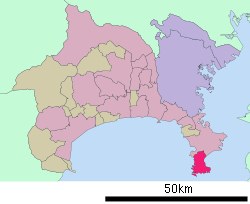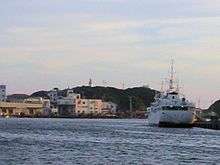Miura, Kanagawa
| Miura 三浦市 | |||
|---|---|---|---|
| City | |||
|
Miura City Hall | |||
| |||
 Location of Miura in Kanagawa Prefecture | |||
 Miura
| |||
| Coordinates: 35°9′N 139°37′E / 35.150°N 139.617°ECoordinates: 35°9′N 139°37′E / 35.150°N 139.617°E | |||
| Country | Japan | ||
| Region | Kantō | ||
| Prefecture | Kanagawa Prefecture | ||
| Government | |||
| • Mayor | Hideo Yoshida (since June 2005) | ||
| Area | |||
| • Total | 32.05 km2 (12.37 sq mi) | ||
| Population (April 1, 2017) | |||
| • Total | 44,132 | ||
| • Density | 1,400/km2 (3,600/sq mi) | ||
| Time zone | Japan Standard Time (UTC+9) | ||
| City symbols | |||
| • Tree | Japanese black pine | ||
| • Flower | Crinum | ||
| • Bird | Japanese cormorant | ||
| Phone number | 046-882-1111 | ||
| Address | 1-1 Shiroyama-cho, Miura-shi, Kanagawa-ken 238-0298 | ||
| Website |
www | ||



Miura (三浦市 Miura-shi) is a city located in central Kanagawa Prefecture, Japan.
As of April 1, 2017, the city had an estimated population of 44,132, with 17,473 households,[1] and a population density of 1,400 persons per km2. The total area is 32.05 km2.
Geography
Miura is located on the very southern end of Miura Peninsula in southeast Kanagawa Prefecture, surrounded on three sides by the Pacific Ocean, with Sagami Bay to the west. To the south of the urban area and port is the island of Jōgashima, connected to the city by a bridge. It is a popular destination for weekend tourism. The Jōgashima Lighthouse was built by the French engineer Léonce Verny at the end of the 19th century.
Surrounding municipalities
- Kanagawa Prefecture
Climate
| Climate data for Miura (1981 - 2010) | |||||||||||||
|---|---|---|---|---|---|---|---|---|---|---|---|---|---|
| Month | Jan | Feb | Mar | Apr | May | Jun | Jul | Aug | Sep | Oct | Nov | Dec | Year |
| Record high °C (°F) | 18.7 (65.7) |
21.8 (71.2) |
22.1 (71.8) |
26.5 (79.7) |
29.6 (85.3) |
32.8 (91) |
36.4 (97.5) |
36.0 (96.8) |
35.9 (96.6) |
29.2 (84.6) |
24.5 (76.1) |
22.6 (72.7) |
36.4 (97.5) |
| Average high °C (°F) | 10.4 (50.7) |
10.7 (51.3) |
13.5 (56.3) |
18.4 (65.1) |
22.1 (71.8) |
24.6 (76.3) |
28.1 (82.6) |
30.4 (86.7) |
27.0 (80.6) |
21.8 (71.2) |
17.1 (62.8) |
12.9 (55.2) |
19.8 (67.6) |
| Daily mean °C (°F) | 6.4 (43.5) |
6.6 (43.9) |
9.3 (48.7) |
14.1 (57.4) |
18.0 (64.4) |
20.9 (69.6) |
24.4 (75.9) |
26.3 (79.3) |
23.2 (73.8) |
18.1 (64.6) |
13.4 (56.1) |
9.0 (48.2) |
15.8 (60.4) |
| Average low °C (°F) | 2.5 (36.5) |
2.6 (36.7) |
5.3 (41.5) |
10.1 (50.2) |
14.5 (58.1) |
18.1 (64.6) |
21.8 (71.2) |
23.5 (74.3) |
20.3 (68.5) |
14.9 (58.8) |
9.7 (49.5) |
5.2 (41.4) |
12.4 (54.3) |
| Record low °C (°F) | −3.8 (25.2) |
−3.6 (25.5) |
−1.8 (28.8) |
−0.2 (31.6) |
7.2 (45) |
11.8 (53.2) |
14.8 (58.6) |
17.7 (63.9) |
11.8 (53.2) |
6.2 (43.2) |
2.9 (37.2) |
−1.7 (28.9) |
−3.8 (25.2) |
| Average precipitation mm (inches) | 56.1 (2.209) |
69.8 (2.748) |
129.6 (5.102) |
134.3 (5.287) |
136.9 (5.39) |
183.4 (7.22) |
158.3 (6.232) |
128.0 (5.039) |
195.5 (7.697) |
192.6 (7.583) |
111.9 (4.406) |
60.3 (2.374) |
1,556.8 (61.291) |
| Average precipitation days (≥ 1.0 mm) | 5.8 | 6.4 | 11.5 | 10.8 | 10.4 | 11.7 | 9.8 | 6.9 | 10.9 | 10.7 | 7.9 | 5.7 | 108.5 |
| Mean monthly sunshine hours | 176.6 | 165.1 | 166.3 | 186.1 | 182.1 | 140.0 | 177.2 | 225.3 | 152.5 | 147.4 | 154.1 | 176.3 | 2,051 |
| Source #1: [http://www.data.jma.go.jp/obd/stats/etrn/view/nml_amd_ym.php?prec_no=46&prec_ch=%90_%93%DE%90%EC%8C%A7&block_no=0392&block_ch=%8EO%89Y&year=&month=&day=&elm=normal&view= Japan Meteorological Agency | |||||||||||||
| Source #2: 観測史上1〜10位の値(年間を通じての値) | |||||||||||||
History
The area of modern Miura has been inhabited since prehistoric times. Archaeologists have uncovered numerous remains from the Japanese paleolithic, Jōmon and Yayoi periods. From the late Heian period through the end of the Sengoku period, the area was ruled by the Miura clan. During the Edo period, it was tenryō territory ruled directly by the Tokugawa shogunate.
After the Meiji Restoration, the town of Misaki within Miura District, Kanagawa was created on April 1, 1889. The town was electrified in 1913, but did not have running water until 1934.
The area was badly shaken during the 1923 Great Kantō earthquake, which had its epicenter in Sagami Bay just a few kilometers offshore from the city. The whole geographical area around the city was lifted by about 10 meters by tectonic movement, before subsiding to its original level during the next few days. No major tsunami was recorded.
On January 1, 1955, Misaki absorbed neighboring Minami-Shitaura Town and Hasse Village to create the city of Miura. The city was connected to the Tokyo Metropolis by rail on July 7, 1966 with the opening of Miurakaigan Station on the outskirts of the city. The line was extended to Misakiguchi Station on April 26, 1975, but plans to further extend the line to the city center have been abandoned.
Miura has been the arrival point of several trans-Pacific sailboat races, such as the 1969 San Francisco-Tokyo Transpacific Yacht Race. Misaki was also the arrival point of the record solo circumnavigation of 71-year-old Minoru Saito, on June 6, 2005.
Economy
The economy of the city is dominated by commercial fishing, centered on the harbor of Misaki, Japan's 18th most important fishing harbor, and the 2nd for its catch of tuna. Misaki is an important fishing harbor, mainly specializing in the processing of tuna. The harbor also has a quay which can accommodate sailboats from neighboring marinas.
Agriculture remains important to the local economy, especially watermelon and daikon.
Transportation
Railway
Highway
Education
Miura is home to Misaki Fisheries High School, a specialist fishery high school. The school trains students in one of four commercial fisheries skills: radio communications, engineering, food processing, and ocean fishing. The school maintains two fishing vessels, one of which is the ocean-going tuna fishing ship Shōnan Maru, launched in 2005. The Shōnan Maru is a frequent visitor to the port of Honolulu as part of the training programme.
Local events
Miura is well known for the Miura Marathon which is normally held in the first week of March. The race consists of three events: 5 kilometer, 10 kilometer, and a half marathon.
Sister city relations
 Suzaka, Nagano, Japan
Suzaka, Nagano, Japan Warrnambool, Victoria, Australia.
Warrnambool, Victoria, Australia.
Notes
- ↑ "Official website of Miura City" (in Japanese). Japan: Miura City. Retrieved 6 May 2017.
References
- Info about Kitesurfing on the beach Muira is also Warrnambools sister City.
External links
| Wikisource has original text related to this article: |
![]() Media related to Miura, Kanagawa at Wikimedia Commons
Media related to Miura, Kanagawa at Wikimedia Commons
- Miura City official website (in Japanese)
- Miura City official website (in English)

